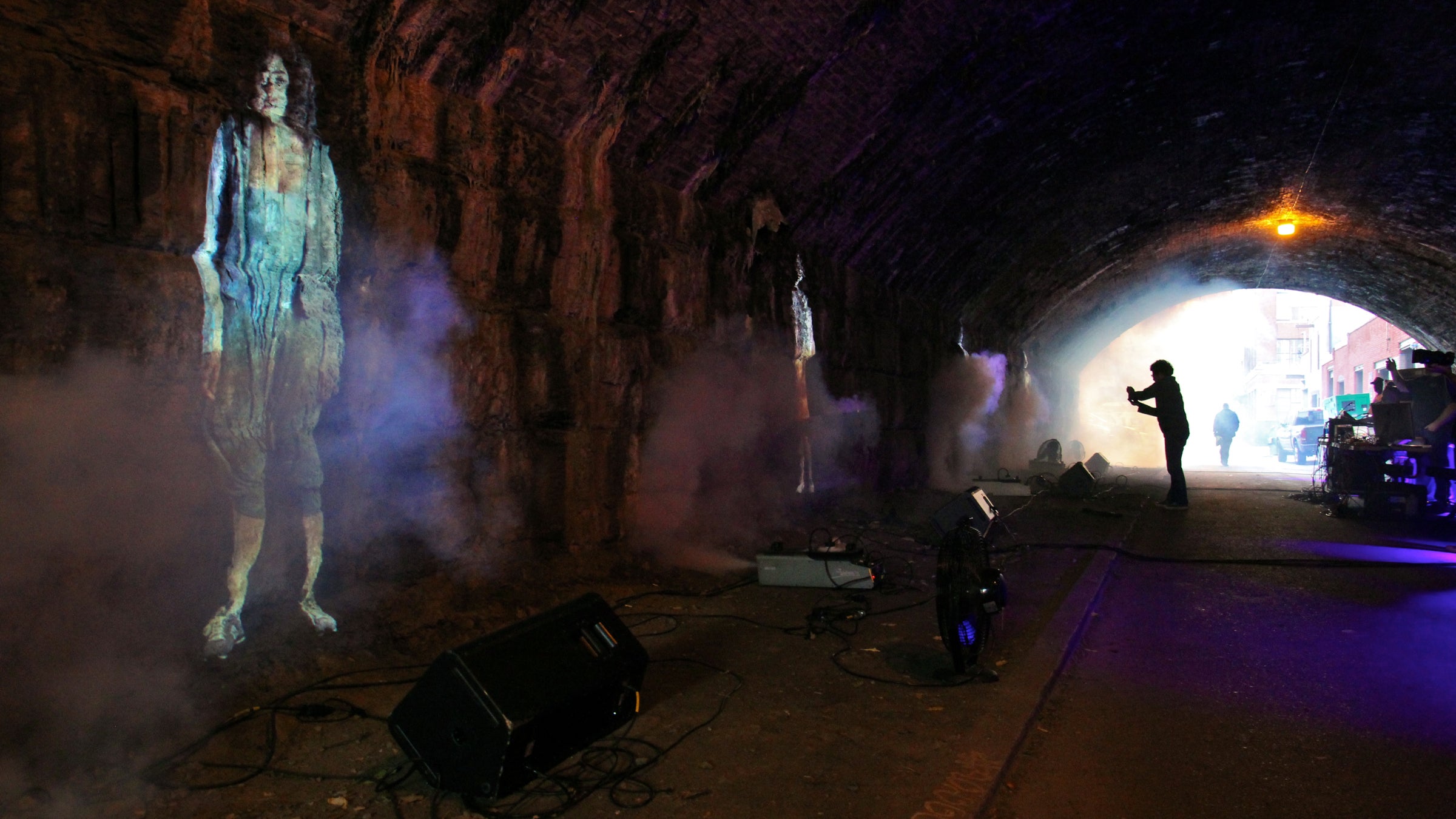Echoes of three centuries take female form to express Callowhill’s harsh history
Listen
Smoke machines produce an eerie mist as four projected women sing their stories under the under the Reading Viaduct at Carlton Street. (Emma Lee/WHYY)
As the raised viaduct railway in Philadelphia’s Callowhill neighborhood gets ready to transform into a park, the sordid history of what lies beneath is being teased out.
“Unsung,” a one-time only installation of video and sound, evokes centuries of sex trade in what historically had been a red-light district. A staggered, continuous loop of video projections on the stained stone wall accompany ambient soundscapes punctuated by scratchy sounds of a live police scanner wired into sheets of corrugated tin.
The Mural Arts Program provided sound artist (Nadia Botello), two video artists (Matthew Suib and Nadia Hironaka), and a pile of historical research in order to create a public work at 11th and Carleton streets, reflecting the past and present of Callowhill, sometimes called Chinatown North.
“It was immediately apparent to us there were people not represented in the capital-H historical record. They were women,” said Suib. “We asked for additional research. What about women in the neighborhood. What have they been doing for the past 300 years?”
Most of the existing documents and newspaper reports point to prostitution. If women were doing anything else in the neighborhood, it did not survive in written accounts.
One of the primary historical resources was “A Guide to the Stranger, or a Pocket Companion to the Fancy, Containing a List of the Gay Houses and Ladies of Pleasure in the City of Brotherly Love and Sisterly Affection,” in the archives of the Library Company of Philadelphia.
It does exactly what the title says: lists brothels and reviews them for safety, cleanliness, and quality, “to warn the stranger and gay city bucks against the possibility of being involuntarily induced to visit a low pest house.”
You can browse pages of the guide to local brothels below.
The first two listings are literally around the corner from the “Unsung” installation, at 11th and Wood streets, where the houses of Miss Sarah Turner and Miss Josephine Somers came highly recommended, the ladies in their employ “beautiful and accomplished.”
“A lot of the houses were listed as great for married women,” said Hironaka. “Why? We realized it’s for married women having affairs. It’s a safe place to take your lover.”
Hironaka also discovered a kind of support network for prostitutes. The women could visit a neighborhood bookstore run by a sympathetic Frenchman to find, behind the counter, birth control and tonics to prevent venereal diseases.
300 years later, some things have not changed
The Callowhill neighborhood is rapidly changing. The old brick warehouses are becoming repurposed. A few yards from the tunnel are new, multi-story loft apartments. The visionary Rail Park plan has just gotten the state funding needed to start construction.
“There are still women in the neighborhood working in brothels, being exploited, having no voice because of position of dependency,” said Suib. “It’s changed quite a bit — lofts and art galleries and restaurants. In other ways, it’s the same as it was 300 years ago.”
The installation features four women, all imagined characters based on historic findings: an 18th century sex worker; an 19th century Irish immigrant whose missing husband was killed laying railroad track outside the city; a 20th century immigrant forcibly moved to America to work in servitude; and a narrator of “The Pocket Companion to the Fancy.”
Historic texts were given to singers, who vocalized the words into melodic lines. Sound designer Botello electronically manipulated those recordings, layering phrases and stretching passages into wordless drones.
As raw aural material, the historical texts lose much of their coherence. Couched with video projections and the ambiance of the grimy stone tunnel, the sound becomes a visceral experience.
“I come hang out in the tunnel. To hear the acoustics, I sing in there,” said Botello. “That’s how I imagine as I compose. It’s impossible to know until you’re in there.”
The effect of the installation is a spooky one, with ghostly projections, fog machines, and ominous atmospheric sounds. But the artists are not making a Halloween show; they say this is about remembering centuries of women who have been forgotten in the neighborhood.
WHYY is your source for fact-based, in-depth journalism and information. As a nonprofit organization, we rely on financial support from readers like you. Please give today.





